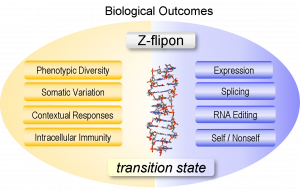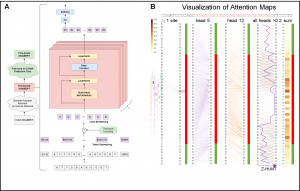Z-DNA and its function
CHARLESTOWN, MA, UNITED STATES, May 12, 2023/EINPresswire.com/ — In a paper just published online in the Life Science Alliance entitled “Z-flipon variants reveal the many roles of Z-DNA and Z-RNA in health and disease”, researchers from InsideOutBio and the Bioinformatics Department at the Higher School of Economics used the Chatbox deep learning transformer algorithm originally developed at Google to map with high precision and accuracy sequences that form the high energy left-handed Z-DNA conformation. The findings were supported by a variety of experimental findings that are able to map this structure genome wide by using chemical modification of DNA in cells. These regions that can adopt alternative conformations under physiological conditions are called flipons and the algorithm they developed is called Z-DNABERT, Many new roles for Z-DNA in health and disease were discovered.
The mapping allowed the researchers to ask how Z-DNA affects different traits and affects risk of mendelian diseases. They found correlative evidence that some traits like height , body mass and lipids are connected with the ability of particular genes to form Z-DNA in their regulatory regions . The researchers were also able to show that Z-DNA forming regions overlap large scale deletions associated with a wide range of mendelian diseases. Specifically they found that experimentally validated flipons had a 2-9% overlap with diseases listed in the Mendelian Catalog, while there was an 8.6% overlap with those flipons that the algorithm predicted. The mendelian diseases reported affect many different genes and outcomes including HBA1 (hemoglobinopathies), CDKN2A (melanoma susceptibility), MC1R (red hair color, melanoma), WNT1 (osteogenesis imperfecta, type xv), NPHS1 (nephrotic syndrome, Type 1), SOX10 (Waardenburg syndrome, Type 2e), IDUA (Hurler–Scheie syndrome), LAMB3 (heterotaxy), IL17RC (familial candidiasis), and FOXL2 (blepharophimosis, ptosis, and epicanthus inversus, type I). Other examples noted but not examined in depth target other genes including TERC, (the telomerase RNA) , TERT, TP53, LMNA, NKX2.5, HBA2, and NROB1 genes
The findings add to the already established roles for left-handed Z-RNA and Z-DNA in innate immunity. In such cases, flipons activate pathways that protect self against attack by viruses. Drugs that modulate flipon conformation offer a new therapeutic avenue for the treatment of cancer. As with all new areas of research, the findings just published require more experimental evaluation to further understand their significance. However, they provide evidence that flipons impact a wide range of biological processes.
The team at InsideOutBio was led by Alan Herbert and Maria Poptsova heads the group at the Higher School of Economics. InsideOutBio, a startup works on approaches to enhance immune responses against refractory cancers.
The manuscript is available at https://www.life-science-alliance.org/content/6/7/e202301962
Alan Herbert
InsideOutBio, Inc
6178007531 ext.
email us here
Visit us on social media:
Twitter
LinkedIn
![]()






















